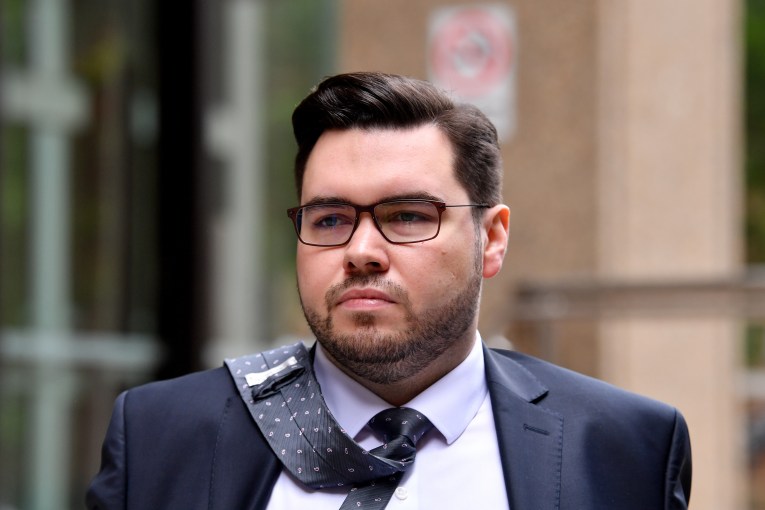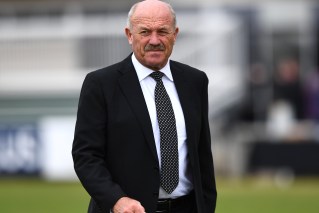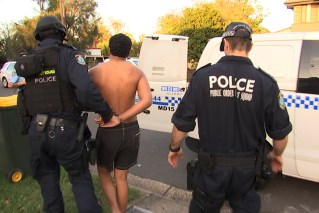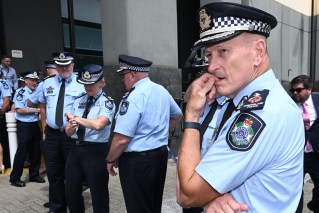Many plans but still no solutions to youth crime crisis that won’t go away
The latest iteration of a “youth crime crackdown” has Annastacia Palaszczuk trying to meet community expectations. As Sean Parnell writes, that can be a difficult game.
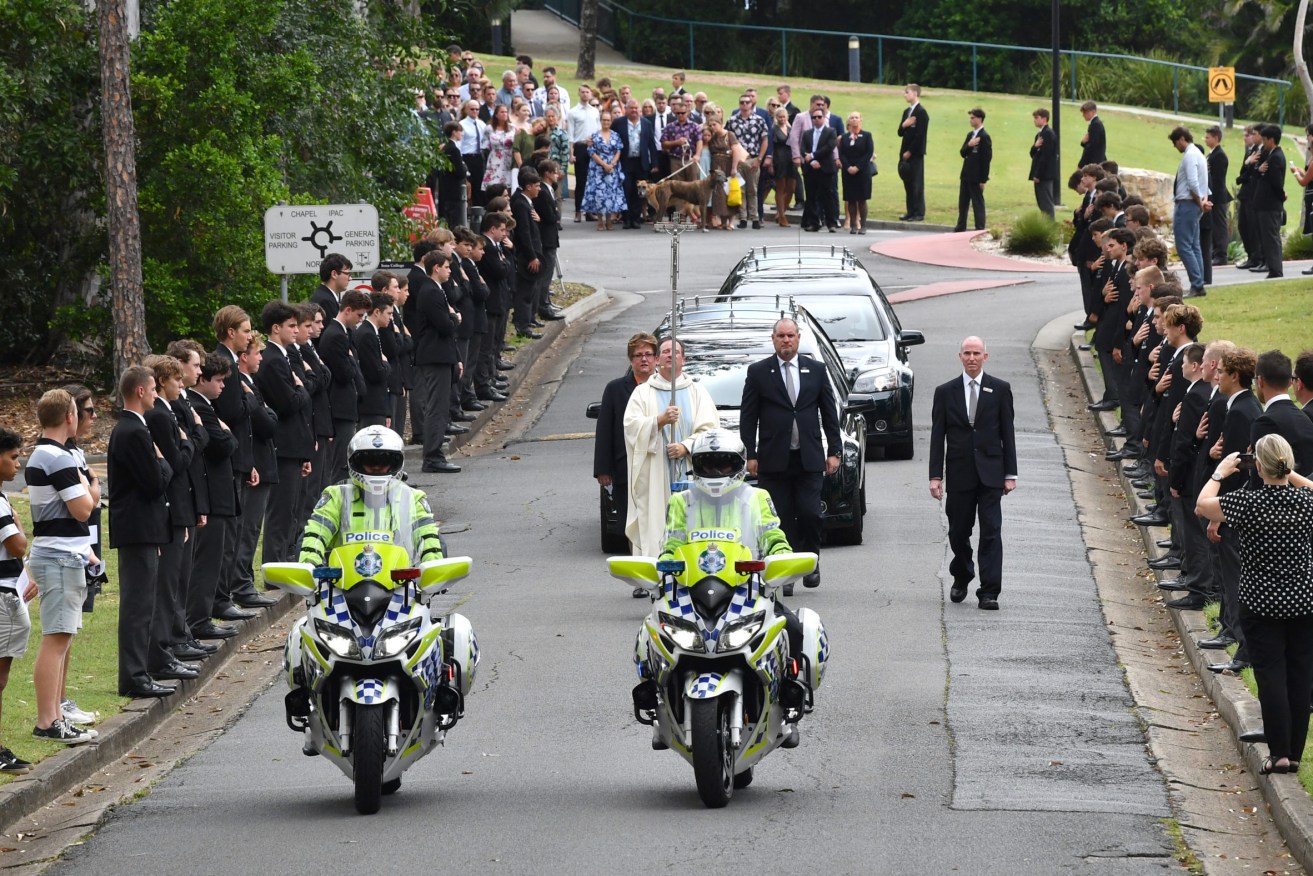
Family and friends are seen as two hearses containing the coffins of Matt Field and Kate Leadbetter are given a guard of honour by students at Iona College in Brisbane on Monday. (AAP Image/Darren England)
Unfair though it may be on law-abiding locals, Townsville is the epicentre of Queensland’s “youth crime crisis”. It was where, in the last election campaign, the Liberal National Party proposed a curfew for young people, and where, following the road crash death of Jennifer Board at the weekend, police announced a taskforce targeting repeat offenders.
Townsville has local problems that require local solutions. Before the taskforce there was the police flying squad – announced just before the state election campaign – which was also meant to target repeat offenders. Before the flying squad there was the Townsville Stronger Communities Action Group, which had the right intent, set up to help address the factors that see young people repeatedly offend.
Clearly, the danger in people continually breaking the law, particularly from a young age, is that they will keep doing so until someone is killed, and only then will they be locked up for a long time. But it is a difficult, multi-faceted problem to address, even if some believe that pre-emptive jailing is the best and only solution. The priority must surely be to prevent crime.
The tabloids set the scene for the latest crackdown by declaring Board’s death was “what it took” for Premier Annastacia Palaszczuk to act on a state-wide problem of out-of-control youth.
“Action comes too late for tragic Jennifer,” the Sunday Mail screamed.
Yet hours before Board was killed, allegedly by a vigilante motorist chasing a car allegedly stolen by a teenage repeat offender, Palaszczuk had promised action. The Premier had flagged as much a week earlier, in response to the deaths of Alexandra Hills couple Kate Leadbetter and Matt Field, and their unborn son Miles, who were hit and killed by a stolen car allegedly driven by a teenager on bail for traffic offences.
On Friday, Palaszczuk fronted the media to declare, five times, “everything’s on the table,” except for the LNP’s old favourite boot camps. Bail laws and GPS trackers were again up for consideration.
“There’ll be announcements next week,” Palaszczuk said. Today, those announcements were made through the tabloids, their articles then shared on the Premier’s Facebook page.
Palaszczuk had only just returned from holidays – catching up on a few days cancelled when Greater Brisbane went into lockdown – to finalise her government’s response to the Alexandra Hills tragedy. While she was away, the LNP Opposition, led by former Townsville MP David Crisafulli, continued campaigning for the government to do something to protect the public, including making bail breaches a criminal offence. The Townsville tragedy only amplified the calls for change.
The Premier did not hide the fact her government was in reactive mode. Closed-door discussions on Friday led to a longer-than-normal Cabinet session on Monday in an effort to “meet community expectations”.
“The community expects us to do more,” said Palaszczuk of the fourth term Labor government.
The measures announced today must be seen in that light. You could be forgiven for thinking you have heard of some of them before. There certainly isn’t much detail around what has gone wrong.
As much as this is painted as a ‘youth crime crisis,’ the number of young offenders was recently recorded to be at a 10-year low. The issue is the repeat offenders – one in 10 committing half of the crimes – who seemingly continue to offend, waiting for the courts to catch up with them. Authorities have been aware of this issue for years, and there is a lack of evidence as to whether or not previous interventions – costing taxpayers hundreds of millions of dollars – have had any impact. Now, more at-risk offenders and suspects are likely to be kept in custody, or fitted with GPS trackers (the fine print has yet to be finalised).
Without going into the particulars of the Townsville and Alexandra Hills cases, who was to blame and whether they could have been stopped, it is worth considering the cycle of reactive politics and whether or not it works. This is the same cycle that comes into play when there is controversy around young people being kept in custody, around the age of criminal responsibility, around the criminal justice system breeding more criminals.
A common theme in the comments on tabloid newspaper articles and Facebook recently has been that people with a criminal history, particularly teenagers, should “never have been let out,” that keeping them in jail would solve the problem. That may be true. Certainly, the courts should be taking into account the risk of someone re-offending when deciding on bail applications, and the government should inform the public of what normally occurs in such cases. That they don’t is ridiculous.
There also have to be thresholds for punishment based on the type of offences or patterns of behaviour – normally the public debate is around violent crimes, but at its core the latest debate is about the failure to get tougher on previous traffic offences. We could be having a debate about stolen cars and dangerous driving, and whether police need more resources or the threat of tougher penalties, but instead we have drifted into another debate about the ‘youth crime crisis’. Again, the government is trying to meet public expectations while avoiding the prospect of pre-emptive jailing (even reversing the onus of proof for bail only applies to more serious indictable offences).
Another taskforce, conducting another review into youth justice, will be headed by veteran police officer Cheryl Scanlon, who today acknowledged the need to focus on the “root cause” and how the home environment and personal circumstances is influencing some repeat offending. Former police commissioner Bob Atkinson will be brought back to examine progress in youth justice. This is where the real work will hopefully be done, taking account of the other new trials.
Today’s announcements aren’t just too late for Board, and Field, and Leadbetter, they propose measures that are perhaps too late in the process to prevent crime occurring. Combined, these measures might make some would-be criminals think twice – about hooning, about carrying knives to nightclubs, about breaching bail – but more needs to be done to ensure the idea doesn’t even enter their head in the first place.
Victims of crime, and their families, deserve a considered, proactive response from a government able to demonstrate, over time, that it knows what is best. They don’t have that yet, and until they do Queensland’s never-ending “youth crime debate” will continue.
